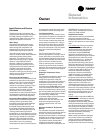
96 SCXG-SVX01B-EN
Owner
Sequence of
Operation
Compressor Safety Devices
The compressors have motor
temperature cutout switches in the motor
windings. These switches are provided to
take the compressors off line during high
motor winding temperature conditions.
If a compressor low pressure cutout
opens during compressor start-up, the
UCM will not shut the compressor off
during the first two to three minutes after
start-up. This prevents possible nuisance
trips during low ambient start conditions.
See Table O-SO-2.
Each compressor’s discharge line
contains a high pressure cutout. Under
abnormal operating conditions, the cutout
will open to stop compressor operation.
Table O-SO-2. Pressure Cutouts.
Unit High Pressure Low Pressure
Model Cutout Cutout
SXWG 360/270 20/35
SXRG 425/350 12/27
Step Control
Steps of mechanical cooling are control
based on supply air or zone temperature.
See Table O-SO-1 on page 95 for
compressor staging.
Capacity is based on an integrating
control concept. The unit capacity
matches the existing load and maintains
an average supply air temperature within
the supply air setpoint temperature
control band region.
The supply air temperature control band
is centered around supply air tempera-
ture setpoint and is adjustable from 2 to
12 F. In a steady state, the unit will either
maintain a constant level of cooling
capacity with the supply air temperature
within the control band, or the highest
active cooling level will cycle to provide
an average supply air temperature equal
to the setpoint.
If the supply air temperature swings
outside the limits of the control band, the
mechanical cooling capacity will increase
or decrease by one level accordingly. The
change occurs by integrating the tem-
perature offset from the control band
limit.
A minimum time delay of five minutes
follows each change in cooling level. This
time delay promotes stability by allowing
the system to respond to the change
before any further control action occurs.
As the supply air temperature ap-
proaches setpoint, the time duration
between changing levels of cooling
capacity increases.
See Figure O-SO-2 for the typical unit
operating curve. Figure O-SO-3 shows
typical unit performance when supply air
temperature swings exceed the control
band limits.
Adjust the supply air temperature control
Table O-SO-3. IntelliPak
®
Unit Cooling Capacity Percent.
Cooling Stage % Utilized
Unit Tons Cool 1 Cool 2 Cool 3
SCWG 20 53 100 n/a
SCWG 25 53 100 n/a
SCWG 30 47 65 100
SCWG 35 53 100 n/a
Table O-SO-4. Thermostat Controlled Unit Cooling Capacity
Stages.
Unit Cooling Stages
Size Cool 1 Cool 2
% Capacity Utilized % Capacity Utilized
SCWG 20 53 100
SCWG 24 53 100
SCWG 30 65 100
SCWG 35 53 100
SCRG 20 52 100
SCRG 25 47 100
SCRG 32 52 100


















